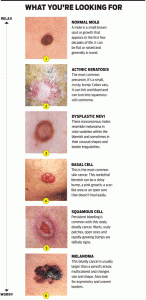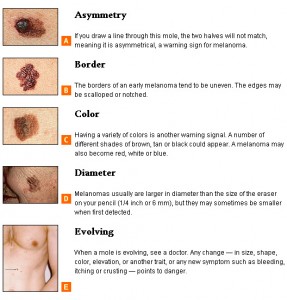
Skin cancer is one of the most common of all human cancers, and is commonly diagnosed throughout the world. Skin cancer is a sudden change in the cells and leads to uncontrolled cell growth, forming a mass called a tumor. Tumors are caused by malignant invasion of surrounding tissues due to excessive growth. Tumors may also travel to distant organs bloodstream. The “melanoma” word comes from ancient Greek melasmeaning “black”, the ancient Greeks and their meaning of the disease, morbidity. Melanoma is a malignant tumor of the skin is often referred to as melanocytes. Malignant melanoma is due to the uncontrolled growth of pigment cells of the skin (melancytes).
 Melanoma is a form of skin cancer – one of the rarest kinds – but is the leading cause of skin cancer related deaths. They develop when normal cells grow and multiply very fastidiously into tumors. They are usually found in the skin but can also appear in the gut and the eye (veal melanoma).
Melanoma is a form of skin cancer – one of the rarest kinds – but is the leading cause of skin cancer related deaths. They develop when normal cells grow and multiply very fastidiously into tumors. They are usually found in the skin but can also appear in the gut and the eye (veal melanoma).
Malignant melanoma is caused by an uncontrolled growth of pigment cells (melancytes). The amount of UV exposure depends on the intensity of light, how long the skin was exposed and the skin covered by clothing or sunscreen. The sun is obviously the main source of UV radiation, but it can also come from tanning booths. Besides lung cancer, skin cancer is one of the most preventable cancers.
Because most of the effected cells make melanin (commonly known as skin pigment), melanoma tumors are often brown or black. Melanoma can almost always be cured as a child. Melanoma is much less common than basal cell and squalors cell skin (described below), but it is much more dangerous. Having dark skin lowers the risk of melanoma, but a person with dark skin can still get it melanoma. . But it is not always the case, and melanoma can also appear pink, beige or even white.
The tumors are usually found in the skin, but can also occur in the gut and the eye (veal melanoma). Many studies also show that sunburns are at an early age increases the risk of skin cancer, even decades later. Melanoma is malignant tumor melanocytes.
 The second major risk is fair skin. It is important to know the stage in order to plan appropriate treatment for skin cancer is because the pigment melanin, provides some protection against UV radiation and those with skin dark have more melanin.. But remember that people of all races and skin colors can get cancer. After the skin of a cancer diagnosis of non-melanoma skin was made, tests are performed to determine if cancer cells have spread to within the skin or other parts of body. for example. People with fair skin, freckles or burns easily are at particularly high risk.
The second major risk is fair skin. It is important to know the stage in order to plan appropriate treatment for skin cancer is because the pigment melanin, provides some protection against UV radiation and those with skin dark have more melanin.. But remember that people of all races and skin colors can get cancer. After the skin of a cancer diagnosis of non-melanoma skin was made, tests are performed to determine if cancer cells have spread to within the skin or other parts of body. for example. People with fair skin, freckles or burns easily are at particularly high risk.
Malignant melanoma may require several treatments, including surgery, radiotherapy and chemotherapy. A biopsy is often the only test needed to determine the stage of cancer non-melanoma skin. Because of the complexity of treatment decisions, people benefit from malignant melanoma of the combined expertise of the dermatologist, a surgeon and cancer oncologist. Lymph nodes may also be examined in case of squalors cell carcinoma to see if the cancer s is spread to them. Treatment of basal cell carcinoma and squalors cell carcinoma is simple.
Approximately 12 years ago I had a mole removed from my upper right thigh (in the groin area). I had two identical moles there from birth…..and no problems with them. After reading much about moles and cancers I decided to have them checked by my Dr. One of them was removed for biopsy and I was told there was no problem at all. Within two or three years the mole started to return…..and instead of being perfectly round as before, it has become elongated and looks nothing like it did before. The other mole has not changed at all. I am just wondering should I have my Dr to look at it……I’m going to do that on my next visit to him. Any comments you may have would be appreciated. Thank you very much.
Yes, have your doctor look at it. An irregularly shaped mole is a warning sign (as well as discolored moles).
Your wrong on the worry level of Squamous cell carcinoma. It is deadly if it spreads to your lymph nodes and other organs especially if it is aggressive. Bcc’s are the least deadly and more locally invasive.